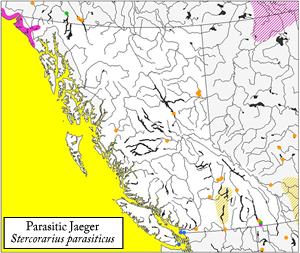Identification of all jaeger species is a complicated procedure, particularly for immature birds. Parasitic Jaeger is intermediate in size and structure between the smaller, more slender Long-tailed Jaeger and the larger, bulkier Pomarine Jaeger. As a result, many identifications rely on subtle differences in structure and flight style rather than plumage characteristics. Long-tailed Jaeger tends to have a more tern-like flight than the falcon-like flight of Parasitic Jaeger, while Pomarine Jaeger has a distinctly gull-like flight style. These characteristics require extensive experience with all three species, however, and are unlikely to be reliable except by very experienced field observers. All adult Parasitic Jaegers show two short, pointed central tail feathers that extens past the tip of the tail. In comparison, Long-tailed Jaeger has very long, pointed central tail feathers, while Pomarine Jaeger has heavy, round-tipped, spoon-shaped central tail feathers.
Light-morph adult Parasitic Jaeger has dark brown upperparts that are intermediate in colour between the paler greyish-brown upperparts of Long-tailed Jaeger and the darker blackish-brown upperparts of Pomarine Jaeger. Light-morph Parasitic Jaeger tends to show a smudgy partial brown band across the breast, whereas Long-tailed Jaeger shows little or no dark breast band and Pomarine Jaeger shows a variable, but usually heavy, dark blackish-brown breast band. The amount of white on the shafts of the primaries of adult Parasitic Jaeger is also intermediate between the other two jaeger species (less white in Long-tailed, more white in Pomarine). Finally, additional field marks include the all dark bill (Pomarine has a bicolored bill), minimal contrast betweent he colour of the upperwing coverts and flight feathers (flight feathers considerably darker and blacker in Long-tailed), the small pale area above the base of the bill (lacking in either of the other jaeger species), and the brownish-black cap (blacker in both other jaeger species).
Due to the complexities of jaeger identification, only certain field marks pertaining to the most commonly-observed adult plumage (light morph) will be discussed here. For further information, including a discussion of immature and dark-morph plumages, readers are directed towards references such as Sibley (2000) or Olsen and Larsson (1997).
| Generally silent at sea, although it may utter a high-pitched weet, weet when feeding on offal. The most commonly-heard calls on the breeding grounds include a nasal KEwet, KEwet…and a short, barking gek. Also gives a “long call” during courtship, which is a series of 1-12 nasal, whining or crowing, bisyllabic feee-leeerrrr notes given at a rate of ~1.3 notes/sec. Source: Wiley and Lee (1999); Sibley (2000) |
Courtship
Pair formation occurs on the breeding grounds. Courtship involves a variety of vocal and behavioural displays, generally beginning with the unpaired male assuming an upright posture as a potential mate apporoaches. During initial contact, the female approaches the male and throws her head back with her bill open; the male responds by bowing his head, raising his tail, and calling loudly. Both birds also emit squeaking calls during this initial encounter. Prior to copulation, the male often engages in courtship feeding and associated behavioural displays, such as lowering of the neck.
Nest
The nest consists of a shallow depression in the ground that is sometimes lined with small amounts of dry grass or lichens; some individuals lay eggs directly on bare ground. The nest depression is created by the female and is typically placed in open areas away from cover, sometimes on a low mound or hummock.
Eggs
A single clutch of (1) 2 eggs is laid by the female in late May or early June and is incubated by both sexes for 24-28 days before hatching. The smooth, slightly glossy eggs are dull olive or buffy (often tinged with green, grey, or brown) with variable spots, blotches, and lines of brown and/or grey that are either evenly distributed or are clustered towards the larger end. Very rarely, some eggs may show a pale blue ground colour. Eggs likely occur in British Columbia between late May and late June.
Young
The young are semi-precocial and downy at hatching, with thick, soft, dark brown to blackish-brown down that is paler and tinged with grey around the eyes, on the chin, on the belly, and at the tips of the wings. Differences between light morph and dark morph individuals are often apparent even at the nestling stage. The short bill is grey with a darker tip and the legs and feet are blue-grey. The young are tended at the nest by both adults for 1-2 days after hatching, but quickly disperse into nearby areas. They are capable of flight by 28-33 days of age, and become fully independent within 7-8 weeks of hatching.
Source: Baicich and Harrison (1997); Wiley and Lee (1999)
|
The Parasitic Jaeger, as with all other jaegers, specializes in kleptoparasitism as a foraging method throughout much of the year. During the breeding season, this species relies less heavily on kleptoparasitism and preys primarily on small birds, small mammals, and eggs that are obtained near the nest site in upland or riparian habitats; other food items such as carrion, berries, insects, and fish are also sometimes consumed in small amounts during the breeding season. Outside of the breeding season, however, kleptoparasitism is the primary means of obtaining food items such as fish, marine invertebrates, and offal. During bouts of kleptoparasitism, the jaeger targets a smaller species such as a storm-petrel, tern, or small gull (Bonaparte’s Gull, Sabine’s Gull, Black-legged Kittiwake) and pursues it mercilessly until the individual disgorges its last meal, which is subsequently consumed by the pursuing jaeger. Although kleptoparasitism accounts for nearly 90% of all foraging activities by individuals outside of the breeding season, this species does also occasionally acquire food items independently by picking them from at or near the surface of the water, and it sometimes pursues and captures small passerines that are migrating over the ocean.
Source: Olsen and Larsson (1997); Wiley and Lee (1999)
|
|

